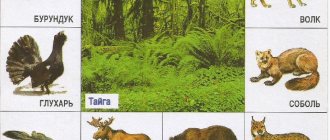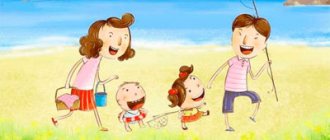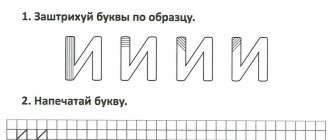Speech therapy lesson in the senior group of a preschool educational institution on the topic “Insects”
- October 18, 2015
Competition “My Pedagogical Initiative - 2015”
Nomination “Methodological work in preschool educational institutions”
The lesson notes have been developed for children of senior preschool age who have a general speech disorder.
Goal: Development of coherent speech using mnemonics.
Tasks:
- activation of the dictionary on the topic “Insects”;
- consolidation and development of the ability to compose a descriptive story according to a plan-scheme;
- strengthening the ability to correctly coordinate numerals and nouns;
- development of attention, visual perception, fine motor skills, memory;
- nurturing love and respect for native nature.
Demonstration material: “Bee” toy, a plan diagram for compiling a descriptive story of an insect, a picture with a schematic image of a butterfly, a ball, paper bees, pictures of insects.
Handouts: boxes with counting sticks, cards with images of insects.
Progress of the lesson
Organizing time. The speech therapist and children are part of the group.
Speech therapist: Children, guests came to our lesson today. Say hello to them (say hello).
Speech therapist: Stand in a circle next to me (takes the ball). Let's play a game.
“Say the opposite” (the speech therapist throws a ball to the child, who returns the ball back - all this is done simultaneously with a verbal selection of antonym words):
The mosquito is evil, but the butterfly, on the contrary, is kind. The bumblebee is big, and the ladybug... is small. The bee is useful, but the fly... is harmful. The wasp lives on the street, and the cockroach... lives at home. The grasshopper jumps, and the ant... crawls. The beetle is buzzing, and the spider... is silent. A dragonfly flies quickly, but a mosquito... flies slowly.
Speech therapist: Who are a mosquito, a fly, a grasshopper, a butterfly?
Children: Insects.
Speech therapist: What other insects do you know?
Children: Dragonfly, ant, cockroach, etc.
Speech therapist: One insect flew to us today. Guess who it is:
He drinks the juice of fragrant flowers and gives us wax and honey. She is sweet to all people. And her name is... (bee).
Speech therapist (shows the “Bee” toy): She arrived not alone, but with her little bees. Oh, guys, look, what did the bees bring us?
Children: Flowers.
Speech therapist: That's right, flowers (the speech therapist takes the first flower and sees the task). Guys, the flowers are not simple, there is something written on them, let’s read it. (The speech therapist reads the first task).
Speech therapist: Guys, the bee invites us to meet her friends. But first we must find them. Look at our clearing, and whoever found it, raise your hand. Begin your statement with the words “I found...”.
(Children take turns naming the hidden insects. The speech therapist hangs the corresponding picture on the board).
Speech therapist: Here they are - the bee’s friends! Guys, do you know that among insects there are beneficial and harmful insects. Name the beneficial insects.
Children: Butterfly, bee, ant.
Speech therapist: What benefits do bees, butterflies, and ants bring?
Children: Bees pollinate flowers, give us honey and wax. Ants carry seeds of many plants throughout the forest. Butterflies pollinate flowers.
Speech therapist: Name the harmful insects.
Children: Fly - spreads germs, caterpillar - eats plant leaves, mosquito.
Speech therapist: Listen carefully to the second task (takes the second flower and reads the task). Guys, the bee invites you to tell us about her insect friends using this diagram.
Speech therapist (opens the next petal): Bee invites us to play a game called “Guess who I am?”
(Selecting a noun for the verb that matches its meaning, playing with a ball)
Flutters (who) - a butterfly Buzzes - a beetle Rings - a mosquito Collects honey - a bee Stings - a wasp Jumps - a grasshopper Works - an ant Flies - a dragonfly.
Speech therapist: Guys, let's show the bees how we can buzz beautifully and ring.
Children: Zh-zh-zh, z-z-z-z.
Speech therapist: Now let’s repeat after the bee:
Zha-zha-zha – we saw a hedgehog. Zhi-zhi-zhi - hedgehogs live under the bush. Zhi-zhi-zhi - hedgehogs are running. Zhu-zhu-zhu - let's give milk to the hedgehog. Zhu-zhu-zhu - I’ll help the hedgehog. Jo-jo-jo - I'm driving a Peugeot.
For-for-for - here comes the goat. For-for-for - here the dragonfly flies. For-for-for - the doll has blue eyes. Zu-zu-zu - I'll feed the goat. Zu-zu-zu - I'm not afraid of a goat. Zy-zy-zy - no goat. Zy-zy-zy - I have two goats. Zya-zya-zya - we saw ide. Zi-zi-zi - bring some tires.
The speech therapist picks off the fourth flower. This flower says that our bee wants to turn us into centipedes. Get up on your feet and repeat after me.
Physical exercise “Centipede”.
1. A centipede walked (children walk with a rhythmic step, slightly springing) along a dry path. 2. Suddenly it began to rain: Drip-drip-drip! (children stop and crouch.) - Oh, forty paws will get wet! 3. I don’t need a runny nose (the children walk, raising their knees high, as if they are walking through puddles), - I’ll go around the puddles! 4. I won’t bring dirt into the house (the children stop and shake one leg), - I’ll shake it with each paw! (shakes the other leg). 5. And then I’ll stomp (children stomp their feet) - Oh, what thunder from the paws!
Speech therapist: Well done guys! Take a seat. Which flower do we pick off?
Children: Fifth.
Speech therapist: Guys, our bee asks us to count whether all her babies are in place. Shall we help the bee? Let's start counting. One bee, two bees and...
Speech therapist: Guys, let's see what the smallest bee has prepared for us.
Speech therapist: And now the bees offer us to play with counting sticks. (Tears off a flower). Guys, take the counting sticks out of the boxes and make a butterfly out of them. You can look at the sample, or you can come up with your own butterfly. (Children complete the task).
Speech therapist: Well done! You have completed all the tasks. Now lie back, close your eyes and listen to me.
Relaxation (to music):
The eyelashes droop, the eyes close. We rest peacefully, fall asleep in a magical sleep, Breathe easily, evenly, deeply. The tension has flown away and the whole body is relaxed. It's like we're lying on the grass, on green soft grass. The sun is shining now. Our hands are warm, our feet are warm. Breathe easily, evenly, deeply. Our hands are resting, Our legs are also resting, They are resting and falling asleep. It's good for us to rest, But it's time to get up. Let's raise our heads higher and breathe easily. Oh, how it smells like spring here. But it's time for us to go home!
Lesson summary
- Our lesson has come to an end. Tell me, who did we talk about today? (We talked about insects.)
– What did you like most? What was difficult for you? (Children answer questions).
Author: Anufrieva Anastasia Aleksandrovna, teacher-speech therapist of MKDOU kindergarten No. 499 “Gnezdyshko”, Novosibirsk.
Prepared by: teacher - speech therapist Natalya Petrovna Sokolovskaya,Municipal educational institution "Saraktashskaya secondary school No. 3" Saraktashsky district, Orenburg region
Tasks:
- updating the dictionary on the topic “Insects”;
- strengthening the ability to correctly coordinate numerals, adjectives and nouns;
- development of logical thinking;
- development of visual attention;
- development of coordination of general movements and finger motor skills;
- development of skills of cooperation, goodwill, independence.
Equipment: subject pictures on the topic “Insects”, a chamomile with tasks, a picture with an overlaid image of insects, sheets of paper with drawn honeycombs, a ball, numbers 1-5, leaves with half-drawn images of a beetle and a butterfly, pencils.
Progress of the lesson:
- Org moment. Development of logical thinking
- Hello guys! Do you want to know who will be our guest in class today? Look at the pictures that lie in front of you: among them are answers to my riddles. Listen carefully to the riddle and pick up the answer picture.
(The speech therapist reads riddles, and the children look for answers)
- In the forest near the stump there is bustle and running around.
The working people are busy all day
From the forest litter
Builds a city for himself. (Ants)
- Dolgoruky old man
I wove a hammock in the corner.
Invites: “Mid flies!
Relax, little ones! (Spider)
- Housewife
Flies over the lawn.
Will fuss over the flower -
He will share the honey! (Bee)
- Children, how can you call an ant, a spider, a bee in one word? (Insects)
- Activation and generalization of students' vocabulary
— Why can’t you see insects outside in winter? (Because it's cold outside, they're sleeping.)
— When do insects appear on the street? (Spring)
- Why in the spring? (It’s getting warm outside, and insects are crawling out of their homes)
- Which of you guys can tell me what external signs all insects have? (Insects have a head, on the head they have antennae, eyes, a proboscis, a jaw, a body, 6 legs - 3 on each side, wings and a sting.)
(The speech therapist shows the external signs of insects in the picture)
— Did you know that the word “insects” comes from the word “notches?” Notches are transverse stripes on the body of insects.
— Raise up a picture of an insect that can be described as “hardworking.”
(Children pick up a picture of a bee.)
- Let's say this phrase together - hardworking bee.
- Today we will have a bee as our guest. She brought with her chamomile, from which she collected honey. But this chamomile is not simple, it is magical. On the back of each petal is written a task that the bee invites us to complete.
- Development of visual attention
— Let’s count together how many petals a chamomile has.
(Children count the petals in unison.)
- So, how many tasks do we have to complete? We must try very hard not to upset our bee.
— We tear off the first petal. We will tear off each petal with the words: “I tore off... a petal.” Tear off, Angelina, and say: “I tore off the first petal!”
(The speech therapist reads the task)
— Guys, the bee invites us to meet her friends. But first we must find them. Look at the picture and whoever found it, raise your hand. Begin your statement with the words “I found (went) ...
(Children take turns naming the hidden insects. The speech therapist hangs the corresponding picture on the board)
- Here they are - the bee's friends! Guys, do you know that among insects there are beneficial and harmful insects.
- Seryozha, go to the board and hang the pictures showing beneficial insects on the right, on the pictures with harmful insects on the left. Look, guys, did Seryozha cope with the task?
— Who will tell you about insects that cause harm? (Flies and mosquitoes are harmful insects. They carry germs and dangerous diseases on their legs.)
—What insects are beneficial? (A bee, ant, grasshopper, butterfly, dragonfly are beneficial insects, they are beneficial. The bee and butterfly pollinate flowers, the grasshopper, ant, dragonfly eat harmful insects.)
- Development of connected speech
- Jean, tear off the second petal and say the words “I tore off the second petal.”
- Listen carefully to the task - “Continue the sentence.” I start a sentence and point to the pictures, and you have to finish my sentence. “Birds eat insects... (bugs, caterpillars, mosquitoes, butterflies,...
—What do the insects themselves eat? (Insects feed on leaves, grass, plant stems - caterpillars, aphids; nectar of flowers - bees and butterflies; other harmful insects - grasshopper, dragonfly and ant; human food remains - flies.)
- Why do we need insects? (They serve as food for birds and pollinate plants)
- Development of finger motor skills
— We tear off the third petal. Varya, tear off and say the words “I tore off the third petal.” And now our bee wants to turn your fingers into a swarm of bees.
(Each child has a sheet of paper with honeycombs drawn. The child’s fingers – index and middle – “walk” – “fly” along the honeycombs on stressed syllables)
Fingers like bees fly through the honeycombs
And they enter each one with a check: what is there?
Will we all have enough honey until spring?
To prevent cold dreams?
- Well done boys! Your fingers looked like happy bees.
- Development of grammatical structure of speech
- Which petal, Adeline, are we tearing off? (“I tore off the fourth petal”)
— I’m reading the task: “Count to five.”
Pictures (bumblebee, dragonfly) and numbers (1 - 5) are attached to the board.
“I’ll start, and you will continue one by one.”
- one furry bumblebee;
- one emerald dragonfly.
(Pay attention to the agreement of the numeral, adjective and noun, the correct pronunciation of the ending)
- Development of general motor skills and vocabulary
- Sasha, tear off the next petal and say our words. (“I tore off the fifth petal”) Bee invites us to play a game called “Guess who I am?”
(Selecting a noun for the verb that matches its meaning, playing with a ball)
- Flutters (who) – butterfly
- Buzzing - beetle
- The mosquito is ringing
- Bee collects honey
- Stings - wasp
- Crawling - caterpillar
- Jumping - grasshopper
- Spider weaves a web
- An ant is working
- Flying - dragonfly
- Name them in one word. Who is this? (Insects)
- Development of graphomotor skills
- The last petal remains. Guys, let's count together how many petals the chamomile had.
(One, two, .... six)
- So, what number of petals did you tear off, Angelina? (“I tore off the sixth petal”)
- Look, each of you has leaves on the table. Turn them over, take the pencils in your hands. The bee’s task is “Complete the dots of your other half.”
(On the tables there are leaves with images of a butterfly and a beetle.)
- Lesson summary
- Our lesson has come to an end. Tell me, who did we talk about today? (We talked about insects.)
What did you like most? What was difficult for you?
(Children answer questions).
- Final lesson in preparation for literacy training. Topic: “In the world of insects”
MADOOU general developmental kindergarten No. 422 “Lorik”, Yekaterinburg
Parents are recommended:
- consider insects (bee, ant, grasshopper, dragonfly, butterfly, ladybug, fly, mosquito, spider),
- discuss their appearance, highlight parts of the body: head, wings, abdomen, antennae, legs,
- tell the child what benefits (harm) insects bring, teach the child to respect nature.
On the topic, children should know:
- names of insects (bee, wasp, bumblebee, fly, snail, dragonfly, grasshopper, worm, ladybug, etc.), insect body parts (sting, wings, proboscis, abdomen, paws...),
- what benefits and harm do insects bring?
- what insects eat (nectar, other insects, human food remains)
Materials for familiarization with the topic:
Let's get acquainted with insects in the presentation: https://cloud.mail.ru/public/3PJV/2eeFYrpMX
Watching insects in a beautiful video: https://cloud.mail.ru/public/2H54/5CNYv2QQE
Speech development tasks:
- “Pick up a word.” Selection of verbs for the word insects: What do insects do? they fly, flutter, crawl, jump, suck, bite, sting, collect, drink, buzz, ring, buzz, bother, harm, help, fly over, hide, fall asleep, wake up, crawl out, work, carry.
- “Call it affectionately”: spider - spider, mosquito - ..., cockroach - ..., bee - ..., fly - ..., beetle - ..., dragonfly - ...
- “Change the word”: a yellow butterfly is yellow, a white butterfly is white.
Change this way: black ant, gray mosquito, red ladybug, blue beetle, green grasshopper, striped wasp.
- “Whose paws, whose head?”
An ant has ant legs and an ant head. The bee has ……… legs, …….. head. A mosquito has …….. legs, ……… head. The cockroach has …… legs, …….. head. The spider has ………… legs, ……. head.
- “Giant insects”: the use of words with magnifying connotations. A spider is a spider, a beetle is a bug, an ant is ..., a mosquito is ..., a worm is ..., a bumblebee is ..., a bug is ...., a cockroach is .....
- “Who moves how?” Composing complex sentences with the meaning of opposition. The child not only selects the right word, but also repeats the entire sentence.
An ant crawls, and a butterfly... A caterpillar crawls, and a grasshopper... A butterfly flies, and a snail... A beetle crawls, and a dragonfly... A wasp flies, and a worm... A snail crawls, and a dragonfly... A spider crawls, and a bee... A wasp flies, and a worm... A grasshopper jumps , and the mosquito... The cockroach crawls, and the dragonfly... The butterfly flutters, and the fly...
- Retell the story “Centipede” using reference pictures:
Once upon a time there lived a centipede. She was going to visit. She looked out the window. And it's raining outside. The centipede began to put on rubber boots. While forty legs were shod, the sun began to shine. The centipede began to take off its boots. While I was taking everything off, it began to snow. The centipede decided to wear felt boots. By the time forty feet were shod, winter was over. Since then, the centipede has been walking barefoot.
- The game “it happens - it doesn’t happen”: understanding logical and grammatical structures.
A girl catches a butterfly. The girl is caught by a butterfly. A butterfly is caught by a girl. The butterfly catches the girl. The girl caught a butterfly. The butterfly caught the girl, etc.
- Complete the sentences:
Maxim holds a spider in his palm, although...... (although he is afraid of them, although it is a dangerous spider, etc.) Katya saw a butterfly on the street, although.... (although it was still early spring, late autumn) The butterfly flew away, although... ..
- Count the insects (agreeing nouns with numerals): one fly, two flies... five flies.
- Solve the crossword puzzle
- Game "Who flies to whom"





